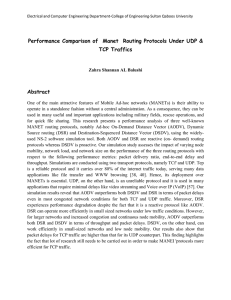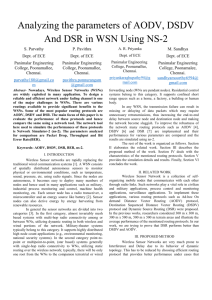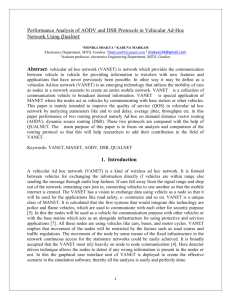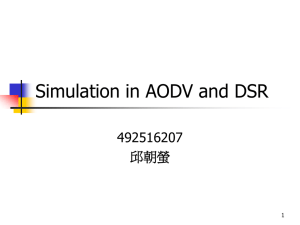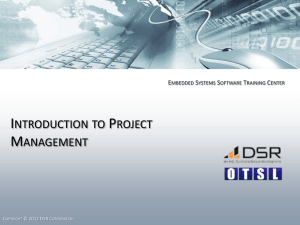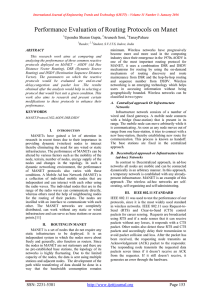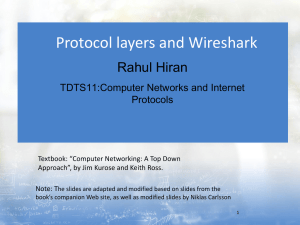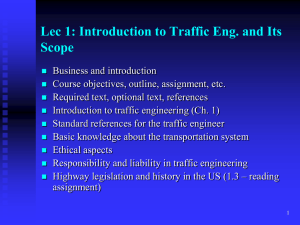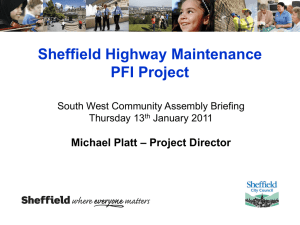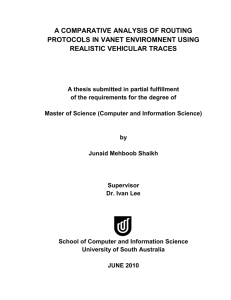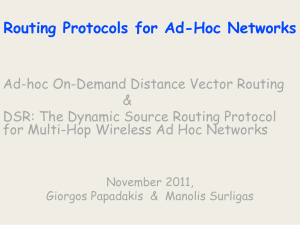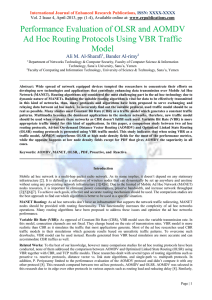PPT Version of Presentation Slides
advertisement
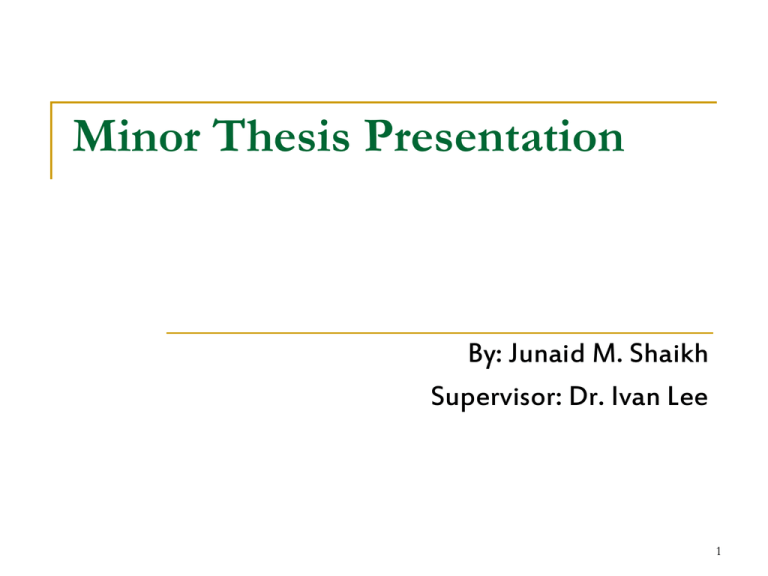
Minor Thesis Presentation
By: Junaid M. Shaikh
Supervisor: Dr. Ivan Lee
1
A Comparative Analysis of Routing Protocols
in VANET Environment Using
2
OUTLINE
INTRODUCTION
RESEARCH OBJECTIVES
WORKFLOW
SIMULATIONS
DEMO
RESULTS
EVALUATION
CONCLUSIONS
FUTURE WORK
3
INTRODUCTION
Technology is moving us from wired to wireless networks
Structured Networks (WLAN)
Unstructured Networks (Mobile Ad hoc Network - MANET)
Vehicular Ad hoc Network – VANET
4
VANET
Vehicles form network
Vehicles equipped with
Wireless transceivers
Computerized control modules
Roadside Units
Drop point
Geographically relevant data
Gateway to internet
VANET Scenario (Source: MoNet Lab)
5
VANET APPLICATIONS
Safety
Accident avoidance warnings
Rapid rescue service
Convenience
Detour information
Toll road payments
Geographically-oriented local information
Entertainment
Internet access
Multimedia entertainment
V2V Communication
6
RESEARCH CONSIDERATION
Network Layer
Ad hoc Routing Protocols
Proactive (routes update periodically)
Reactive (routes update on-demand)
DSDV
AODV
AOMDV
DSR
Nodes Movement
7
RESEARCH OBJECTIVES
Analyzing data dissemination in VANETs
Identify and Study Routing Protocols in VANET
Highest Delivery Ratio
Lowest End-to-End Delay
Mobility Models
Deploy realistic vehicular traces
Obtained: Multi-agent microscopic traffic simulator (MMTS)
Developed: K. Nagel (at ETH Zurich)
Available for research community
8
NS-2 (Network Simulator)
Network simulator targeted at networking research
Almost complete OSI features with open-source
Simulation components
Nodes (hardware entities)
Agents (software entities; TCP, UDP)
Links (for nodes connections)
Traffic generators (source, sink)
Simulation operations
Event scheduler
Network creation
Tracing, etc
9
WORKFLOW
Mobility and Traffic Generator
City Scenario
Highway Scenario
TCL File with support of Mobility Patterns, Comm. Paradigms, Reliability
constraints, and Related Parameters
NS-2 Simulator
Compile
AODV
AOMDV
DSR
DSDV
Multiple Trace & NAM Files
Trace File Analysis (Preferably AWK Script)
10
SIMULATIONS
City Model
Density Levels
Low
Medium
High
Highway Model
Density Levels
Low
Medium
High
11
CITY MODEL (Parameters)
Common Parameters
Variable
Simulation time
Topology size
Routing Protocols
Traffic Type
Value
Specific Parameters
Density Level
Variable
No. of Nodes
Max. Connections
Low
12
8
Medium
260
150
High
812
150
300 s
4000 m x 7000 m
AODV, AOMDV, DSR, DSDV
TCP
12
CITY MODEL (Mobility Traces)
Google Map View
Simulator View
13
HIGHWAY MODEL (Parameters)
Common Parameters
Variable
Simulation time
Topology size
Routing Protocols
Traffic Type
Value
Specific Parameters
Density Level
Variable
No. of Nodes
Max. Connections
Low
370
150
Medium
837
150
High
1112
150
300 s
14000 m x 10000 m
AODV, AOMDV, DSR, DSDV
TCP
14
HIGHWAY MODEL (Mobility Traces)
Google Map View
Simulator View
15
DEMO
CITY
HIGHWAY
16
CITY
17
HIGHWAY
18
TRACE FILE & AWK SCRIPT
M
s
r
s
r
r
s
0.01000 7 (3076.65, 4672.97, 0.00), (3198.59, 4629.61), 13.65
2.556838879 _1_ AGT --- 0 cbr 512 [0 0 0 0] ------- [1:0 2:0 32 0]
2.556838879 _1_ RTR --- 0 cbr 512 [0 0 0 0] ------- [1:0 2:0 32 0]
2.560742394 _1_ RTR --- 1 DSR 32 [0 0 0 0] ------- [1:255 2:255 32
2.561962728 _4_ RTR --- 1 DSR 32 [0 ffffffff 1 800] ------- [1:255
2.561963021 _6_ RTR --- 1 DSR 32 [0 ffffffff 1 800] ------- [1:255
2.604736825 _1_ RTR --- 2 DSR 32 [0 0 0 0] ------- [1:255 2:255 32
#packet delivery ratio
#
# Sent tcp packets
#
if($4 == "AGT" && $1 == "s" && seqno < $6) {
seqno = $6;
}
#receivedPacketSeqno[receivedPackets] = $12;
#
# Received tcp packets
#
#else if((($6%2) == 1) && ($1 == "r") && ($7 == "tcp")){
else if (($4 == "AGT") && ($1 == "r")){
rpkt++;
}
[0] 0 0
[0] 0 0
0] 1 [1 1] [0
2:255 32 0] 1
2:255 32 0] 1
0] 1 [1 2] [0
1 0 0->0] [0 0 0 0->0]
[1 1] [0 1 0 0->0] [0 0 0 0->0]
[1 1] [0 1 0 0->0] [0 0 0 0->0]
2 0 0->16] [0 0 0 0->0]
#
# end-to-end delay
#
if($4 == "AGT" && $1 == "s") {
start_time[$6] = $2;
} else if(($7 == "tcp") && ($1 == "r")) {
end_time[$6] = $2;
} else if($1 == "D" && $7 == "tcp") {
end_time[$6] = -1;
}
}
19
RESULTS (CITY)
City Model
3 Density levels
4 Routing protocols
12 Trace files
Routing Metrics
Packet Delivery Ratio
Average End-to-End Delay
20
RESULTS (CITY)
Packet Delivery Ratio
120.00%
Delivery Percentage (%)
100.00%
80.00%
City Low Density
60.00%
City Medium Density
City High Density
40.00%
20.00%
0.00%
AODV
AOMDV
DSR
Routing Protocols
DSDV
21
RESULTS (CITY)
Average End-to-End Delay
450
400
350
Time (msec)
300
250
City High Density
200
City Medium Density
City Low Density
150
100
50
0
AODV
AOMDV
DSR
Routing Protocols
DSDV
22
RESULTS (HIGHWAY)
Highway Model
3 Density levels
4 Routing protocols
12 Trace files
Routing Metrics
Packet Delivery Ratio
Average End-to-End Delay
23
RESULTS (HIGHWAY)
Packet Delivery Ratio
120.00%
Delivery Percentage (%)
100.00%
80.00%
Highway Low Density
60.00%
Highway Medium Density
Highway High Density
40.00%
20.00%
0.00%
AODV
AOMDV
DSR
Routing Protocols
DSDV
24
RESULTS (HIGHWAY)
Average End-to-End Delay
300
250
Time (msec.)
200
Highway High Density
150
Highway Medium Density
Highway Low Density
100
50
0
AODV
AOMDV
DSR
Routing Protocols
DSDV
25
EVALUATION
Evaluative Routing Metrics
Routing Protocols
AODV
AOMDV
DSDV
DSR
Weighting
Packet Delivery Ratio
Factor
Rating
4
4
4
4
3
2
2
1
Score
16
Average End-to-End Delay
Rating
Total Score
Score
2
8
2
8
24
6
3
9
15
2
4
8
10
16
Weighted Evaluation Matrix
24
26
CONCLUSIONS
Through major aspects of rigorous simulations followed
by certain evaluations,
AODV and AOMDV remained preferable for both city
and highway scenarios used in for this project.
DSDV good in city scene but not suitable for highway
DSR remained acceptable only for E2E delay
Total Score
30
25
20
15
Total Score
10
5
27
0
AODV
AOMDV
DSDV
DSR
FUTURE WORK
Mobility Traces
Adelaide’s Data
Utilize Test Bed
New routing protocols
28
29
Thank you for listening. Q&A
